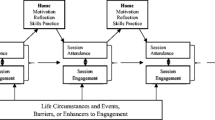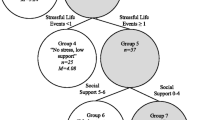Abstract
This study examined parent characteristics and barriers to participation in a community-based preventive intervention with a sample of 201 parents from low-income and predominantly ethnic minority backgrounds. Person-centered analyses revealed five subgroups of parents who demonstrated variability in their parent characteristics, which included psychological resources and level of parental involvement in education. Group membership was associated with differences in school involvement and use of the psychoeducational intervention at home, after accounting for the number of barriers to engagement. For the intervention attendance variable, greater number of barriers was associated with decreased attendance only for parents in the resilient subgroup and the psychologically distressed subgroup. Attendance remained constant across levels of barriers for the other three subgroups of parents. The results of the study inform theory and practice regarding how to tailor preventive interventions to accommodate subgroups of parents within populations that experience barriers to accessing mental health services.


Similar content being viewed by others
References
Administration for Children and Families. (2006). Head start performance measures center, family and child experiences survey (FACES 2000): Technical report. Washington DC: Department of Health and Human Services.
Atkins, R. J. (2005). The association of childhood personality type with volunteering during adolescence. Merrill-Palmer Quarterly, 51, 145–162.
Baydar, N., Reid, M. J., & Webster-Stratton, C. (2003). The role of mental health factors and program engagement in the effectiveness of a preventive parenting program for head start mothers. Child Development, 74, 1433–1453.
Brannan, A. M. (2003). Ensuring effective mental health treatment in real-world settings and the critical role of families. Journal of Child and Family Studies, 12, 1–10.
Brannan, A. M., Heflinger, C. A., & Foster, E. M. (2003). The role of caregiver strain and other family variables in determining children’s use of mental health services. Journal of Emotional and Behavioral Disorders, 11, 77–91.
Bronfenbrenner, U. (1979). The ecology of human development: Experiments by nature and design. Cambridge, MA: Harvard University Press.
Bussing, R., Zima, B. T., Gary, F. A., & Wilson Garvan, C. (2003). Barriers to detection, help-seeking, and service use for children with ADHD symptoms. The Journal of Behavioral Health Services & Research, 30, 176–189.
Cairns, R. B., Bergman, L. R., & Kagan, J. (1998). Methods and models for studying the individual. Thousand Oaks, CA: Sage Publications, Inc.
Campbell, S. B., Cohn, J. F., & Meyers, T. (1995). Depression in first-time mothers: Mother–infant interaction and depression chronicity. Developmental Psychology, 31, 349–357. Psychology, 92, 367–376.
Cicchetti, D., & Lynch, M. (1993). Toward an ecological/transactional model of community violence and child maltreatment: Consequences for children’s development. Psychiatry: Interpersonal and Biological Processes, 56, 96–118.
Cicchetti, D., & Rogosch, F. A. (1999). Conceptual and methodological issues in developmental psychopathology research. In P. C. Kendall, J. N. Butcher, & G. N. Grayson (Eds.), Handbook of research methods in clinical psychology (2nd ed., pp. 433–465). Hoboken, NJ: John Wiley & Sons, Inc.
Coatsworth, J. D., Duncan, L. G., Pantin, H., & Szapocznik, J. (2006). Patterns of retention in a preventive intervention. The Journal of Primary Prevention, 27, 171–193.
Fantuzzo, J., Tighe, E., & Childs, S. (2000). Family Involvement Questionnaire: A multivariate assessment of family participation in early childhood education. Journal of Educational Psychology, 92, 367–376.
Frazier, S. L., Abdul-Adil, J., Atkins, M. S., Gathright, T., & Jackson, M. (2007). Can’t have one without the other: Mental health providers and community parents reducing barriers to services for families in urban poverty. Journal of Community Psychology, 35(4), 435–446.
Garland, A. F., Lau, A. S., Yeh, M., McCabe, K. M., Hough, R. L., & Landsverk, J. A. (2005). Racial and ethnic differences in utilization of mental health services among high-risk youths. American Journal of Psychiatry, 162, 1336–1343.
Greenberg, M. T., Speltz, M. L., DeKlyen, M., & Jones, K. (2001). Correlates of clinic referral for early conduct problems: Variable- and person-oriented approaches. Development and Psychopatholgy, 13, 255–276.
Heinrichs, N., Bertram, H., Kuschel, A., & Hahlweg, K. (2005). Parent recruitment and retention in a universal prevention program for child behavior and emotional problems: Barriers to research and program participation. Prevention Science, 6, 275–286.
Helms, J. E., Jernigan, M., & Mascher, J. (2005). The meaning of race in psychology and how to change it. American Psychologist, 60, 27–36.
Hoff, E., Laursen, B., & Tardif, T. (2002). Socioeconomic status and parenting. In M. H. Bornstein (Ed.), Handbook of parenting: Vol. 2. Biology and ecology of parenting (2nd ed ed., pp. 231–252). Mahwah, NJ: Lawrence Erlbaum.
Kazdin, A. (1993). Premature termination from treatment among children referred for antisocial behavior. Journal of Child Psychology and Psychiatry, 31, 415–425.
Kazdin, A. (2000). Perceived barriers to treatment participation and treatment acceptability among antisocial children and their families. Journal of Child and Family Studies, 9, 157–174.
Kazdin, A. E., Holland, L., & Crowley, M. (1997). Family experience of barriers to treatment and premature termination from child therapy. Journal of Consulting and Clinical Psychology, 65, 453–463.
Kazdin, A. E., Mazurick, J. L., & Bass, D. (1993). Risk for attrition in treatment of antisocial children and families. Journal of Clinical Child Psychology, 22, 2–16.
Kazdin, A. E., & Wassell, G. (1999). Barriers to treatment participation and therapeutic change among children referred for conduct disorder. Journal of Clinical Child Psychology, 28, 160–172.
Kazdin, A. E., & Wassell, G. (2000). Predictors of barriers to treatment and therapeutic change in outpatient therapy for antisocial children and their families. Mental Health Services Research, 2, 27–40.
Kazdin, A. E., & Whitley, M. K. (2003). Treatment of parental stress to enhance therapeutic change among children referred for aggressive and antisocial behavior. Journal of Consulting and Clinical Psychology, 71, 504–515.
Kerkorian, D., McKay, M., & Bannon, W. M. (2006). Seeking help a second time: Parents’/caregivers’ characterizations of previous experiences with mental health services for their children and perceptions of barriers to future use. American Journal of Orthopsychiatry, 76, 161–166.
Lamb-Parker, F., Piotrkowski, C. S., Baker, A. J. L., Kessler-Sklar, S., Clark, B., & Peay, L. (2001). Understanding barriers to parent involvement in head start: A research-community partnership. Early Childhood Research Quarterly, 16, 35–51.
MacNaughton, K. L., & Rodrigue, J. R. (2001). Predicting adherence to recommendations by parents of clinic-referred children. Journal of Consulting and Clinical Psychology, 69, 262–270.
McKay, M. M., McCadem, K., & Gonzales, J. J. (1996). Addressing the barriers to mental health services for inner city children and their caretakers. Community Mental Health Journal, 32, 353–361.
Mendez, J. L., Stillman, L., LaForett, D. R., Wandersman, A., & Flaspohler, P. (2004). Neighborhood and community influences favoring the growth and development of young children. In T. Gullota & M. Bloom (Eds.), A blueprint for the promotion of prosocial behavior in early childhood (pp. 113–139). Stanford: CWA Press.
Miller, G. E., & Prinz, R. J. (2003). Engagement of families in treatment for childhood conduct problems. Behavior Therapy, 34, 517–534.
Morrissey-Kane, E., & Prinz, R. J. (1999). Engagement in child and adolescent treatment: The role of parental cognitions and attributions. Clinical Child and Family Psychology Review, 2, 183–198.
NICHD Early Child Care ResearchNetwork. (1999). Chronicity of maternal depressive symptoms, maternal sensitivity, and child functioning at 36 months. Developmental Psychology, 35, 1297–1310.
Pearlin, L. I., & Schooler, C. (1978). The structure of coping. Journal of Health and Social Behavior, 22, 337–356.
Perrino, T., Coatsworth, J. D., Briones, E., Pantin, H., & Szapocznik, J. (2001). Initial engagement in parent-centered preventive interventions: A family systems perspective. The Journal of Primary Prevention, 22, 21–44.
Petterson, S. M., & Albers, A. B. (2001). Effects of poverty and maternal depression on early child development. Child Development, 72, 1794–1813.
Radloff, L. (1977). The CES-D Scale: A self-report depression scale for research in the general population. Journal of Applied Psychological Measurement, 1, 385–401.
Ross, C. E., Mirowsky, J., & Huber, J. (1983). Dividing work, sharing work, and in-between: Marriage patterns and depression. American Sociological Review, 48, 809–823.
Snell-Johns, J., Mendez, J. L., & Smith, B. H. (2004). Evidence-based solutions for overcoming access barriers, decreasing attrition, and promoting change with underserved families. Journal of Family Psychology, 18, 19–35.
Spoth, R., Redmond, C., Hockaday, C., & Shin, C. Y. (1996). Barriers to participation in family skills preventive interventions and their evaluations: A replication and extension. Family Relations: Journal of Applied Family & Child Studies, 45, 247–254.
Tabachnick, B. G., & Fidell, L. S. (2006). Using multivariate statistics (5th ed.). Boston: Allyn & Bacon.
U.S. Public Health Service. (2000). Report of the surgeon general’s conference on children’s mental health: A national action agenda. Washington DC: Health and Human Services.
Von Eye, A., & Bergman, L. R. (2003). Research strategies in developmental psychopathology: Dimensional identity and the person-oriented approach. Development and Psychopathology, 15, 553–580.
West, J., Denton, K., & Reaney, L. (2001). The Kindergarten Year (NCES 2001-023). U.S. Department of Education. Washington DC: National Center for Education Statistics.
Wright, D., Germina-Hausken, E., & West, J. (1994). Family-child engagement in literacy activities: Changes in participation between 1991 and 1993. National Center for Education Statistics, National Data Resource Center.
Yeh, M., McCabe, K., Hough, R. L., Dupuis, D., & Hazen, A. (2003). Racial/ethnic differences in parental endorsement of barriers to mental health services for youth. Mental Health Services Research, 5, 65–77.
Acknowledgments
This research was supported by a Head Start Quality Research Center Consortium grant awarded to the first author by the Department of Health and Human Services. Institutional support was provided by the University of South Carolina and Temple University for research and graduate training for students involved in this project. We thank the research participants and members of the Head Start communities who were so generous with time and involvement in this project.
Author information
Authors and Affiliations
Corresponding author
Rights and permissions
About this article
Cite this article
Mendez, J.L., Carpenter, J.L., LaForett, D.R. et al. Parental Engagement and Barriers to Participation in a Community-Based Preventive Intervention. Am J Community Psychol 44, 1–14 (2009). https://doi.org/10.1007/s10464-009-9252-x
Published:
Issue Date:
DOI: https://doi.org/10.1007/s10464-009-9252-x




